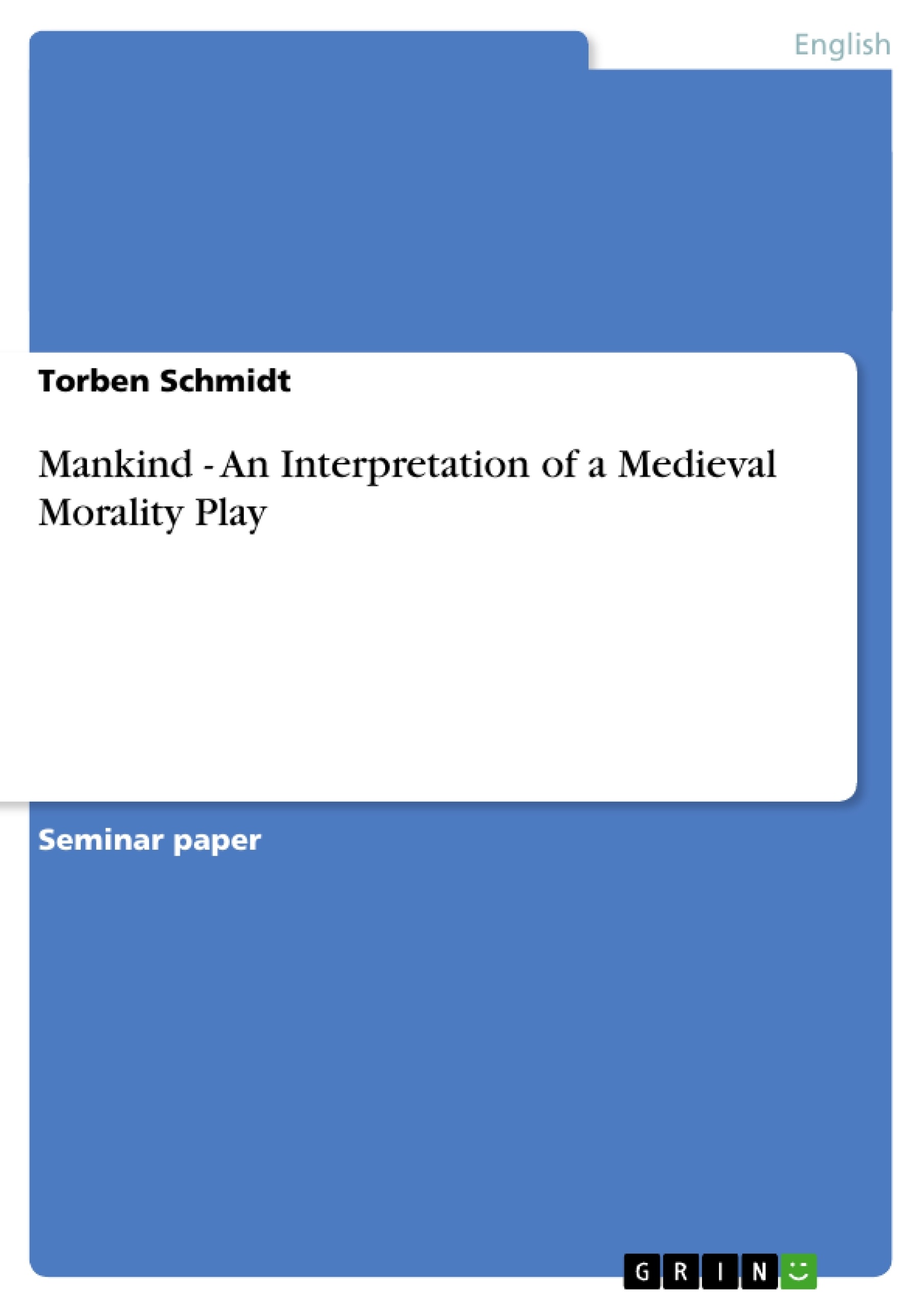There are some obvious differences between the morality and the miracle plays. The
latter did stress moral truths besides teaching facts of the bible, but on the whole did
not lend themselves to allegorical formulation except when there was no well –
defined Bible story to be followed. A good example in this case is the life of Maria
Magdalen, before she was converted. The miracle play dealt with what were believed
to be historical events and its main characters were for the most part ready- made for
the playwright by the Bible and inherited tradition.
The morality play on the other hand, stood by itself, unconnected to a cycle, and the
plots were extremely stereotyped. “They afforded less scope for original creation
than those of the miracles, which were crowded with major and minor characters,
Herold, Pilate, Pharaoh, Noah’s wife, Satan, Adam and Eve,” (Kinghorn 1968:
p.116) and a host of others, both scriptural and non-scriptural. As far as the
characters in the morality plays are concerned one could say that these characters,
like for instance the Seven Deadly Sins, did only offer very limited opportunities for
development. “Gluttony could hardly be other than a fat lout, Sloth a half- awake
lounger, Luxury an overdressed woman, Avarice a grasping old man and Anger
continually in a rage”( Kinghorn 1968: p.116).
As far as allegorical formulations are concerned it has to pointed out that the
morality play characters were always personified vices and virtues, producing a
conflict of sorts and providing enough material for a plot. The Christian Virtues, the
Seven Deadly Sins, Pride of Life, World, Flesh Youth, Age, Holy Church, Wealth,
Health, Mercy, Learning and, of course, Mankind are just a few examples for
personages which were made to behave as though they were human by the didactic
aim of the author ( Kinghorn 1968: p.116), but all these characters are always
contained within their own narrow definition. Since these allegorical personages
were not characters but walking abstractions, they provided the playwright only very
limited opportunities for development. Everything that was said and done by these
characters showed clearly the moral truth which was of course the subject of the plot. The late medieval morality plays mark a well - defined movement away from the
religious drama towards the completely secular drama in England. [...]
Inhaltsverzeichnis
- Basic facts about Mankind
- Characters in the Morality Plays
- The Author of Mankind
- Sources and Analogues
- The Staging of Mankind
- A Summary of the Plot
- The Significance of Mankind
- An Interpretation of the "Court Scene"
- The genesis of Shakespeare's theatre in Mankind
- Works Cited
Zielsetzung und Themenschwerpunkte
Die Hausarbeit "Mankind — An Interpretation of a Medieval Morality Play" analysiert das mittelalterliche Moralspiel "Mankind" und untersucht seine Bedeutung im Kontext der Entwicklung des englischen Dramas. Die Arbeit beleuchtet die Figuren, den Autor, die Quellen und die Inszenierung des Stücks. Zudem wird eine Interpretation der "Court Scene" präsentiert und die Genese des Shakespeare'schen Theaters im Kontext von "Mankind" betrachtet.
- Die Entwicklung des englischen Dramas vom religiösen zum weltlichen Theater
- Die Charakterisierung der Figuren in mittelalterlichen Moralspielen
- Die Bedeutung von lateinischer Sprache und Humor im Stück
- Die Rolle von Moral und Unterhaltung im mittelalterlichen Theater
- Der Einfluss von "Mankind" auf die Entwicklung des Shakespeare'schen Theaters
Zusammenfassung der Kapitel
Das erste Kapitel beleuchtet die grundlegenden Fakten über "Mankind". Es werden die Charaktere in Moralspielen im Vergleich zu Mirakelspielen analysiert, wobei die typischen Figuren wie die Sieben Todsünden und die personifizierten Tugenden hervorgehoben werden. Das Kapitel beleuchtet auch die Anonymität des Autors und die möglichen Quellen und Analogien des Stücks, wobei Einflüsse aus Werken wie "The Assembly of God" und "Piers Plowman" diskutiert werden. Die Inszenierung von "Mankind" wird ebenfalls betrachtet, wobei die möglichen Zeit- und Ortsangaben sowie die Art der Aufführung und das Zielpublikum in den Vordergrund gestellt werden.
Das zweite Kapitel bietet eine Zusammenfassung der Handlung von "Mankind". Die Geschichte beginnt mit einer Predigt von Mercy, die von Mischief unterbrochen wird. Die drei weltlichen Laster Newguise, Nowadays und Nought treten auf und verspotten Mercy. Mankind wird von Mercy zum Ackerbau ermutigt, wird aber von Titivillus, dem Teufel, verführt. Die "Court Scene" wird als ein Höhepunkt der Handlung vorgestellt, in der Mankind von Mischief und seinen Anhängern dazu gebracht wird, Sünden zu begehen. Mercy erscheint schließlich und führt Mankind zurück zur Reue.
Das dritte Kapitel behandelt die Bedeutung von "Mankind". Es wird betont, dass das Stück den Beginn des professionellen englischen Dramas darstellt, da es für Geld aufgeführt wurde. Die "Court Scene" wird als Beispiel für die humorvolle und satirische Darstellung von Autorität und gesellschaftlichen Normen analysiert. Die moralische Botschaft des Stücks, die in der Konfrontation von Gut und Böse liegt, wird jedoch nicht als der wichtigste Aspekt betrachtet.
Das vierte Kapitel untersucht die Genese des Shakespeare'schen Theaters im Kontext von "Mankind". Es wird argumentiert, dass "Mankind" ein Beispiel für ein Theater in Übergang ist, das Elemente des mittelalterlichen Moralspiels mit einem Fokus auf Unterhaltung und Popularität verbindet.
Schlüsselwörter
Die Schlüsselwörter und Schwerpunktthemen des Textes umfassen das mittelalterliche Moralspiel, "Mankind", die Entwicklung des englischen Dramas, Charakterisierung, Quellen, Inszenierung, "Court Scene", Humor, Moral, Unterhaltung, Shakespeare'sches Theater.
- Citar trabajo
- Torben Schmidt (Autor), 2001, Mankind - An Interpretation of a Medieval Morality Play, Múnich, GRIN Verlag, https://www.grin.com/document/10210
-

-

-

-
¡Carge sus propios textos! Gane dinero y un iPhone X. -

-
¡Carge sus propios textos! Gane dinero y un iPhone X. -

-
¡Carge sus propios textos! Gane dinero y un iPhone X. -

-
¡Carge sus propios textos! Gane dinero y un iPhone X. -

-
¡Carge sus propios textos! Gane dinero y un iPhone X. -

-
¡Carge sus propios textos! Gane dinero y un iPhone X.

